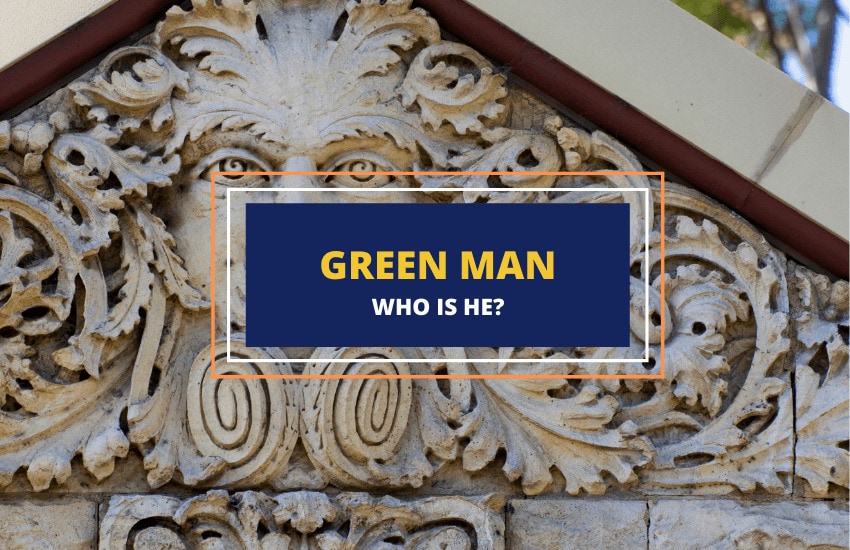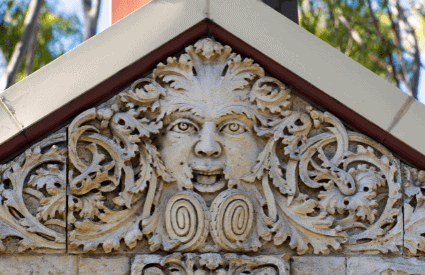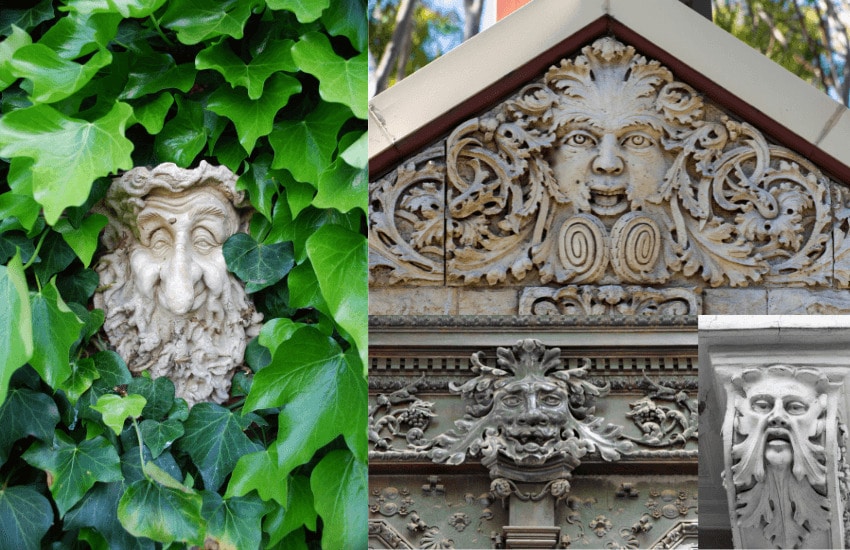
Table of Contents
The Green Man is one of the most mysterious and controversial mythological figures in the world. And we do mean “the world” as this character doesn’t belong to just one mythology. Instead, the Green Man can be found in dozens of different cultures and religions across multiple continents.
From ancient Europe, the Middle East, and Africa, all the way to Eastern Asia and Oceania, variants of the Green Man can be seen almost everywhere, except in the two Americas.
But who exactly is the Green Man? Let’s try to go through a brief overview of this complicated and diverse character below.
Who is the Green Man?

The Green Man is usually portrayed as a green face motif on sculptures, buildings, carvings, and, sometimes on paintings. The exact features of the face aren’t set in stone – pardon the pun – and the Green Man doesn’t seem to be a single person the way most gods are.
However, the face is almost always bearded and covered with leaves, twigs, vines, flowering buds, and other floral features. Many representations also show the Green Man to be spewing vegetation out of his mouth as if creating it and pouring it onto the world. Even though it’s rarely painted green and will typically just have the natural color of the stone it’s carved in, the face is still dubbed a Green Man because of its obvious floral elements.
There are even depictions of the Green Man sprouting vegetation not just from his mouth but from all his facial orifices – his nostrils, eyes, and ears. This can be viewed as a man who’s overwhelmed by nature and isn’t just spreading nature. In that sense, the Green Man can be viewed as a normal man who is defeated and overtaken by the forces of nature.
All this is based on contemporary interpretations, of course, as we can only speculate what the ancient authors meant with this image. It’s possible that different people and cultures meant different things with the Green Man.
Was the Green Man a Deity?
The Green Man is rarely viewed as just a singular deity the way Zeus, Ra, Amaterasu, or any other deity is. It might be that he is a spirit of the forests or of Mother Nature or that he’s an ancient deity that we’ve forgotten about.
However, most scholars believe that the Green Man is a representation of all of the above and of people’s connection to nature. He is a pagan symbol by his very essence, but he doesn’t belong to just one culture. As we’ve already mentioned, variations of the Green Man can be seen throughout the world and are almost always depicted as a flowery and bearded male face carved in stone.
It’s also worth pointing out that many cultures associate the Green Man with their respective agricultural or natural vegetation deities. The Green Man is rarely the deity itself, but is simply associated or related to it – somehow as an aspect of the deity or as a relative to it.
When Was The Term “Green Man” Created?
Even though this is one of the oldest mythological images in the world, the name for it is quite new. The official inception of the term came from Lady Julia Raglan’s 1939 journal Folklore.
In it, she initially referred to him as “Jack in the Green” and described him as a symbol of spring, the natural cycle, and rebirth. From there, all other depictions of similar Green Men started being dubbed as such.
Prior to 1939, most cases of Green Men were viewed individually and historians and scholars didn’t refer to them by any common term.
How Is The Green Man So Universal?

One possible explanation of the universal nature of the Green Man is that he’s so ancient that the common African ancestors we all share believed in him too. So, as the different peoples migrated from Africa across the world they simply brought this image with them. This does feel like a far-fetch explanation, however, as we’re talking about something that happened some 70,000 years ago.
A more widely accepted explanation comes from Mike Harding’s book A Little Book of the Green Men. In it, he postulates that the symbol may have originated in Asia Minor in the Middle East. From there, it could have conceivably spread across the world in a more logical timeframe. This would also explain why there are no Green Men in the Americas as, at that point, they were already populated by people and the land bridge between Siberia and Alaska had melted down.
Another plausible theory is that the logic behind the Green Man is just so intuitive and universal that many cultures developed this image on their own. Similar to how many cultures view the Sun as “male” and the Earth as “female” and associate their union as the cause behind the Earth’s fertility – it’s just an intuitive inference. This doesn’t explain why there are no Green Men in the Americas but that could be due to the fact that these cultures deify their environment more than most others anyway.
Examples of the Green Man in Different Cultures
We can’t possibly list all examples of Green Men across the world as there are literally thousands of them. And those are just the few that we know of.
However, to give you some idea as to how widespread the Green Man is, here are some examples:
- There are sculptures of the Green Man in St. Hilaire-le-grand in Northern France dating back to 400 AD.
- There are also Green Man figures in Lebanon and Iraq from the second century AD, including in the Hatra ruins.
- There are also the famous Seven Green Men of Nicosia. They were carved into the facade of the 13th century St Nicholas Church in Cyprus.
- On the other side of the planet, there is the 8th century Green Man in a Jain temple in Rajasthan, India.
- Back to the Middle East, there are Green Men on 11th century Templar churches in Jerusalem as well.
During the Renaissance, the Green Men began to be depicted in various metalwork, manuscripts, stained glass paintings, and bookplates. The design of the Green Men started varying even more, with countless animalistic examples spreading across Europe.
The Green Man became increasingly popular in Britain come the 19th century, especially in the Arts and Crafts era and during the Gothic Revival period.
The Green Man on Churches
Speaking of churches, one of the most peculiar factoids about the Green Men is that they are incredibly common in churches. Even though they are obviously a pagan symbol, both ancient and medieval sculptors didn’t hesitate to carve them into the walls and murals of churches with the clear knowledge and permission of the church.
Here’s one gorgeous example on a Choir Screen in an Abbey church. There are thousands of other such depictions in churches all across Europe and the Middle East.
A Green Woman? Fertility Goddesses vs. The Green Man
If you look through history you’ll notice that fertility, floral, and nature deities are most commonly women. This seems to stem from the popular motif that the male Sun inseminates the female Earth and she gives birth (which, in a way, can be seen as scientifically accurate too).
But if most nature deities are women, why are the Green Men men? Are there any Green Women?
There are but they are exceedingly rare and mostly contemporary. A good example is Dorothy Bowen’s famous Green Woman silk kimono design. Of course, if we are to leaf through sites like DeviantArt, we’ll see several modern depictions of Green Women but this image simply wasn’t common in ancient and even medieval or Renaissance times.
This seems like a logical disconnect but it really isn’t. Female nature and fertility goddesses were extremely popular, worshipped, and beloved. Green Men don’t contradict or replace them, they are just an additional symbol people associated with nature.
Are All Green-Faced Deities “Green Men”?
Of course, there are many green-faced gods and spirits in the various cultures and religions of the world. The Egyptian god Osiris is one such example as is Khidr, the Muslim servant of Allah in the Qur’an. Hinduism and Buddhism also have various characters and gods that are often portrayed with green faces.
These aren’t “Green Men”, however. Even when they are associated with nature in one way or another, these seem to be more of a coincidence than a direct connection with the Green Man image.
Symbolism of the Green Man
The Green Men can have various interpretations. Most commonly they are viewed as a connection with nature, the past, and humanity’s origins as a part of nature.
It is somewhat surprising that Green Men were allowed in churches but Christianity did allow some pagan beliefs to be retained after converting people as a way to keep them appeased. So, even when the various peoples of the world moved through time and changed religions, they kept connected to their origin through the Green Men.
Another view is that Green Men are meant to be forest spirits and gods who actively spread nature and vegetation around. Sculpting a Green Man onto a building was likely a way to pray for better fertility of the land in that area.
Yet another interpretation we sometimes see is that Green Men were a representation of man’s eventual fall to nature. Some Green Men are depicted as overwhelmed and consumed by nature. This can be viewed as a rejection of modernism and a belief that sooner or later nature will reclaim the realm of man.
It’s difficult to say which of these is more likely and it’s also possible that they are all true, just for different Green Men.
Importance of the Green Man in Modern Culture
People’s fascination with Green Men is noticeable throughout modern culture today. Some famous examples include the story of Peter Pan who is viewed as a type of a Green Man or the myth of the Green Knight from the Arthurian legend of Sir Gawain and the Green Knight (brought to the big screen in 2021 with David Lowery’s The Green Knight movie).
The Tolkien characters of the Ents and Tom Bombadil in The Lord of the Rings are also viewed as variants of the Green Man. There’s also Kingsley Amis’s 1969 novel The Green Man and Stephen Fry’s famous poem The Green Man in his novel The Hippopotamus. There’s also a similar poem in Charles Olson’s Archeologist of Morning book. The famous DC comic book character Swamp Thing is also considered an adaptation of the Green Man myth.
Robert Jordan’s 14-book fantasy epic The Wheel of Time also includes a version of the Green Man in the very first book – a character by the name of Someshta of the Nym race – the ancient gardeners of the world.
Pink Floyd’s first album is an example of that as it’s called The Piper at the Gates of Dawn – a reference to Kenneth Grahame’s 1908 children’s book The Wind in the Willows which included a Green Man by the name of Pan in a chapter called The Piper at the Gates of Dawn.
There’s no end to the examples, especially if we start delving into the anime, manga, or video game worlds. Virtually all ent-like, dryad-like, or other “natural” characters are either partly or entirely inspired by the Green Man myth – that’s how popular and prevalent it is in our culture.
Wrapping Up
Mysterious, prevalent, and a global figure, the Green Man hints at an early connection between the regions of the world, symbolizing nature and its power, fertility, and more. While much about the Green Man is unknown, its influence on modern culture cannot be underestimated.








